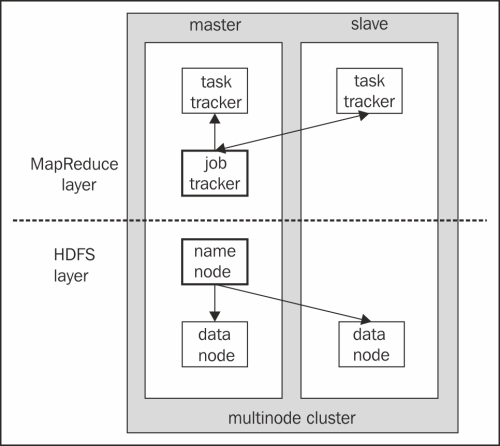Since HDFS and MapReduce are considered to be the two main features of the Hadoop framework, we will focus on them. So, let's first start with HDFS.
HDFS can be presented as the master/slave architecture. HDFS master is named as NameNode whereas slave as DataNode. NameNode is a sever that manages the filesystem namespace and adjusts the access (open, close, rename, and more) to files by the client. It divides the input data into blocks and announces which data block will be store in which DataNode. DataNode is a slave machine that stores the replicas of the partitioned dataset and serves the data as the request comes. It also performs block creation and deletion.
The internal mechanism of HDFS divides the file into one or more blocks; these blocks are stored in a set of data nodes. Under normal circumstances of the replication factor three, the HDFS strategy is to place the first copy on the local node, second copy on the local rack with a different node, and a third copy into different racks with different nodes. As HDFS is designed to support large files, the HDFS block size is defined as 64 MB. If required, this can be increased.
HDFS is managed with the master-slave architecture included with the following components:
- NameNode: This is the master of the HDFS system. It maintains the directories, files, and manages the blocks that are present on the DataNodes.
- DataNode: These are slaves that are deployed on each machine and provide actual storage. They are responsible for serving read-and-write data requests for the clients.
- Secondary NameNode: This is responsible for performing periodic checkpoints. So, if the NameNode fails at any time, it can be replaced with a snapshot image stored by the secondary NameNode checkpoints.
MapReduce is also implemented over master-slave architectures. Classic MapReduce contains job submission, job initialization, task assignment, task execution, progress and status update, and job completion-related activities, which are mainly managed by the JobTracker node and executed by TaskTracker. Client application submits a job to the JobTracker. Then input is divided across the cluster. The JobTracker then calculates the number of map and reducer to be processed. It commands the TaskTracker to start executing the job. Now, the TaskTracker copies the resources to a local machine and launches JVM to map and reduce program over the data. Along with this, the TaskTracker periodically sends update to the JobTracker, which can be considered as the heartbeat that helps to update JobID, job status, and usage of resources.
MapReduce is managed with master-slave architecture included with the following components:
- JobTracker: This is the master node of the MapReduce system, which manages the jobs and resources in the cluster (TaskTrackers). The JobTracker tries to schedule each map as close to the actual data being processed on the TaskTracker, which is running on the same DataNode as the underlying block.
- TaskTracker: These are the slaves that are deployed on each machine. They are responsible for running the map and reducing tasks as instructed by the JobTracker.
In this plot, both HDFS and MapReduce master and slave components have been included, where NameNode and DataNode are from HDFS and JobTracker and TaskTracker are from the MapReduce paradigm.
Both paradigms consisting of master and slave candidates have their own specific responsibility to handle MapReduce and HDFS operations. In the next plot, there is a plot with two sections: the preceding one is a MapReduce layer and the following one is an HDFS layer.

The HDFS and MapReduce architecture
Hadoop is a top-level Apache project and is a very complicated Java framework. To avoid technical complications, the Hadoop community has developed a number of Java frameworks that has added an extra value to Hadoop features. They are considered as Hadoop subprojects. Here, we are departing to discuss several Hadoop components that can be considered as an abstraction of HDFS or MapReduce.
